Sony A900 Full-Frame: Hands-On Preview
by Wesley Fink on September 12, 2008 12:00 AM EST- Posted in
- Digital Camera
Full-Frame, 24.6MP, and SteadyShot Integrated IS
The A900 is the first Sony DSLR to feature a full-frame sensor. The sensor is approximately the size of a frame of 35mm film, which is 24x36mm.
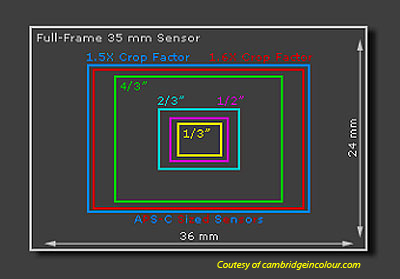
Most digital cameras today use a sensor closer to APS-C size. As a result, lenses mounted on APS-C DSLRs behave as if they are 150% to 200% longer than the marked focal length. Other Sony DSLR cameras, like the A700, also feature a 23.5x15.6mm APS-C sensor.
In the computer world, increasingly smaller traces mean higher density, more transistors, and generally better and faster performance. However, the digital sensor is not a digital device; it is an analog device that gathers light and turns it into a digital signal. Sensors are the reverse of digital electronics in that larger is almost always better in sensors, with everything else equal. More details on how digital sensors actually work can be found in The Digital Sensor.
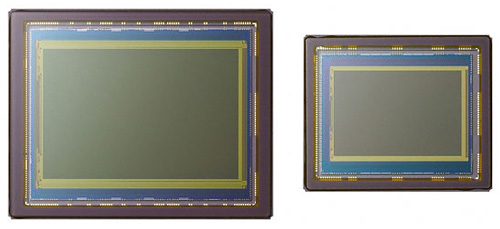
| DSLR Sensor Comparison | ||||
| Camera | Effective Sensor Resolution | Sensor Dimensions and Area |
% of Full-Frame | Sensor Density (MP/cm2) |
| Olympus E-520/E-3 | 10 | 13.5x18 2.43 cm2 |
28.10% | 4 |
| Canon XSi | 12.2 | 14.8x22.2 3.28 cm2 |
38.00% | 3.7 |
| Sony A350 | 14.2 | 15.8x23.6 3.72 cm2 |
42.90% | 3.8 |
| Pentax K20D | 14.6 | 15.6x23.4 3.65 cm2 |
42.20% | 4 |
| Canon 50D | 15.1 | 14.9x22.3 3.32 cm2 |
38.40% | 4.5 |
| Sony A700, Nikon D300, Nikon D90 | 12.3 | 15x23.5 3.66 cm2 |
42.40% | 3.3 |
| Nikon D700/Nikon D3 | 12.1 | 24x36 8.64 cm2 |
100% | 1.4 |
| Canon 5D | 12.7 | 24x36 8.64 cm2 |
100% | 1.5 |
| Canon 1Ds Mark III | 21.1 | 24x36 8.64 cm2 |
100% | 2.4 |
| Sony A900 | 24.6 | 24x35.9 8.61 cm2 |
100% | 2.9 |
The last column in the chart is the one that tells the story most accurately, however. Here the effective sensor resolution is divided by the sensor area to yield a sensor density. The lower the density, the larger the individual pixel size, and the more data that pixel can gather - all else being equal. There are a few surprises here, such as the Sony A350 being essentially the same density as the Canon XSi, and the new Canon 50D having the highest density of any current DSLR camera.
The last column does put into perspective the true potential of the full-frame sensor and shed some light on the true meaning of Sony's 24.6MP A900 sensor. At 2.9MP per cm2, the A900 still exhibits a lower density and theoretically better high ISO performance that any current APS-C DSLR. This is very much at odds with the ridiculous claims many on the web are making about Sony going too high in resolution on the A900. In fact, sensor density on the A900 is lower than the 10MP Canon 40D, which is 3.1.
The point is that any issues Sony may be found to have with noise are not the result of pixels being "too small". All else being equal the high ISO noise should be at least as good as an 8 to 10MP Canon sensor. Where the Sony does suffer is in comparison to sensor density of other full-frame sensors. In that metric the Sony has twice the pixels per cm2 of a Nikon D3/D700 and Canon 5D, and keeping up in high ISO performance with those cameras would be quite a feat.
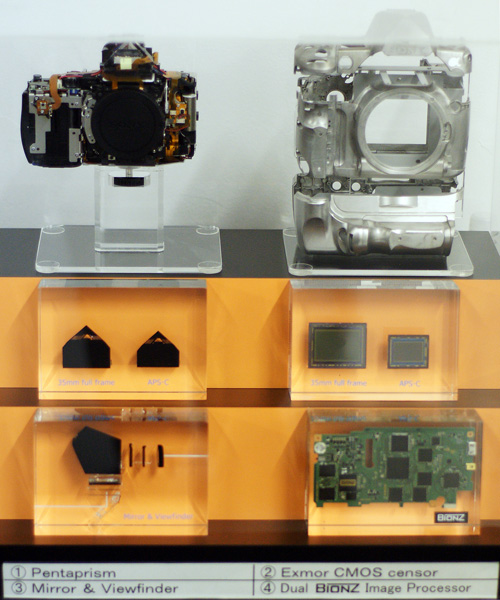
Moving a digital SLR camera to full-frame involves a lot more than just the sensor, however. Everything is bigger, heavier, and more difficult to accomplish. You can clearly see some of those challenges in this Sony case comparing sensors, pentaprisms, the microprocessor to move the huge increase in data (dual BIONZ), and the motors to control the in-camera image stabilization (IS). Rumors were rampant for months that Sony just could not get their signature SteadyShot IS to work in full-frame, which would have been a major failing had it turned out to be true. Now that we have used the A900 hands-on we can report that SteadyShot is definitely working as it should, and Sony still claims a 2.5 to 4.0 stop improvement in hand-holdability in the full-frame A900.
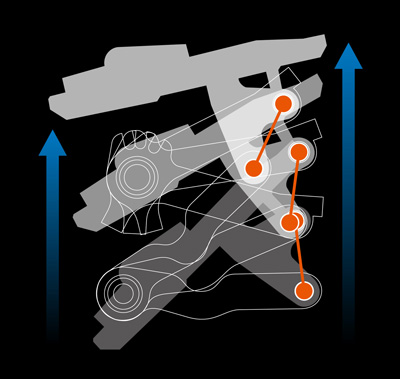
To accomplish this Sony employed a parallel-link to move instead of flip the mirror. This reduced vibration substantially to reduce the demands on SteadyShot. It also had the benefit of allowing a shorter front to back dimension while still utilizing a full-frame mirror.
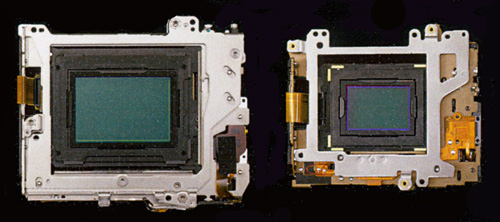
The second innovation was the sensor motors themselves. Since SteadyShot is controlling heavier components in even greater motion than APS-C, the motors required a 50% increase in output. Amazingly, the motors were beefed up, twice as many pixels are being captured and processed with dual BIONSZ processors, and with the same NP-FM5000H battery used in the A700, A350, A300, and A200 they extended the expected battery life in the A900 to 850 shots. Even if you're predisposed to hate Sony because you are a loyal Canon fan, you have to admire the engineering that went into solving many of these challenges.










53 Comments
View All Comments
yyrkoon - Monday, September 15, 2008 - link
If I had any personal gripes with Sony,it would be because of their 'business tactics' in the past with things mentioned by Westley here. Westley made mention of the 'battery issue', but what he did not mention was Sony's bad judgment in the past concerning rootkits.Sure, Sony's motivation for installing 'software' on a system without the users knowledge may have had to do with protecting their IP(DRM), but I have to question any company who deems they have the right to take control of any system that does not belong to them. Also, for those who may think that this is no big deal, keep in mind that even USB thumb drives, etc have their own MAC address.
What does this mean to the end user you may ask ? This means that anyone of us *could* potentially be locked out of the hardware that we payed hard earned cash for at the whim of a company who obviously has serious moral issues.
Thankfully Mark Russinovich caught this back in 2005, but it took several class action suits, and a court order that made Sony pay up $150 to each affected individual before they stopped shipping the CDs(almost two years later).
Now onto the subject of lenses. Zeiss also makes Nikon glass, but according to Ken Rockwell (heh yeah I know . . .) Zeiss actually does not make these lenses(some other company in Japan does), and most of, or all of these are MF. Ken Rockwell then goes on to say - "When photographers want quality they use larger format cameras, not 35 mm. " Nothing he says here really matters to me. All I care about is how well any given lens I purchase performs. I suppose the part he mentions going to a different format for quality does sort of make sense, but since I am not a 'professional photographer', my Nikon DSLR will just have to do . . . The thing is though, Zeiss is not the end all be all of lenses, and other manufactures make good lenses as well (Nikon for one).
I did the research more than 1.5 years ago when purchasing my first DSLR, and at that time, there just was not a broad enough lens selection available for the Alpha 100. Obviously I decided against it(and I do have my reasons), but with shooting pictures with a decent DSLR, I am finding that knowing how to use a camera in the first place makes more of a difference than the 'quality' of equipment used.
In the meantime, while the latest Alpha may have some desirable features, and can use some seemingly nice glass. I think I would have to pass on the 'latest flavor' of the month. Also seems to be yet another company who can not get it into their heads that the 'big MP penis' *thing* was a last year and before trend. While this year savvy photographers have been asking for, and want more dynamic range . . .
melgross - Wednesday, September 17, 2008 - link
Yes. Right now, most of Sony's lenses are old, and not intended for digital sensors. There are a few Zeiss lenses, which are certainly good, though not quite up to the standard of their third party offerings for Nikon, and now Canon. But their Sony models do auto focussing, which the Nikon and Canon models do not.It's surprising that their sony models, at the prices that they sell for are not weather sealed as Canon and Nikon's own lenses are.
Heidfirst - Monday, September 15, 2008 - link
1. Sony have made it very clear all through the A900 development that they do not consider the A900 a Pro body (albeit capable of being used by a Pro).I guess a proper Pro body (or several) comes later if they decide that they really want to seriously target that market.
2. the reason that there is no increase in burst speed in APS-C mode is that Minolta/KM & now Sony have never had a shutter/mirror mechanism that can do more than 5fps i.e. it's the shutter that is the limiting factor not the image processing abilities.
3. batteries - yes, it's dear compared to generics but it's no dearer than equivalent Canon, Nikon, Olympus, Pentax genuine batteries.
& I've got to say that it's a great battery in terms of performance so I don't need as many.
Keepitpro - Sunday, September 14, 2008 - link
Sony is an Industry standard in broadcasting with their video cameras, expect it to become a reference standard in photography as time passes. They have the engineering power to solve problems, and almost an unlimited budget to make things happen. They are the freshman in the SLR market and already making good decisions, it's only a matter of time before they get all of it right. The other question to factor in is how the photo industry will accept Sony as a future industry standard. Artist and photographers tend to stick with what they know and love. Lets see how their incredible marketing team handles that. It might be Sony take over, PS3 stile.Only time will tell.
Milleman - Sunday, September 14, 2008 - link
Looks interresting, but there are a few things that stops me from buying right now. First, it's the first of its kind in a new breed from Sony. Some functions and engineering is just great, while some other seems premature or even absent. Onther big backlash is the batteries. I don't wanna end up with a "Sony-only" choice of battery source. I have have a friend that is tied to the Sony batt-packs, and he claims it is really a pain in the ass.For now on, I'll probably wait until Nikon or Canon turns up with a similar 24 MP unit, just because of what I mentioned.
roweraay - Sunday, September 14, 2008 - link
Actually, the entire range of Konica-Minolta engineers are in Sony's employ and you cannot get any more expertise than that, from a photography perspective, regardless of manufacturer. As far as electronics and sensor technology is concerned, Sony has been doing that for a while, including as a supplier to Nikon.Bottomline, in the "DSLR", the "D" aspect is covered through Sony's own expertise/know-how and the "SLR" aspect is covered through the prior Konica-Minolta engineers.
I would not have too much concern about Sony being new to this field.
They did have some mis-steps when the A700 was initially released one year back, by applying NR onto RAW (BAD in my book) but they have completely reversed course, with the upcoming release on Sept.16th, of Firmware Ver.4, which completely changes things for the better.
Now the RAW files are virgin-untampered-RAW-files (with the NR-OFF setting) and is unbelievably detailed even at ISO 6400 and seemingly has even more luminance data in it than its peer, the Nikon D300 (which shares roughly the same sensor).
chiew - Sunday, September 14, 2008 - link
how much is sony paying you ;)i'm going to wait for some side by side comparisons by phil askey, etc before putting my money into something that isn't even on the market yet.
rjm55 - Sunday, September 14, 2008 - link
I suppose if you have already decided to buy Canon or Nikon then waiting for Phil's side-by-side makes sense. You can always be sure Canon or Nikon will be the winner in Phil's reviews. And dpreview and their parent Amazon are obviously paying me nothing.chiew - Sunday, September 14, 2008 - link
are you saying you are more qualified to compare cameras side by side than phil or any other site's reviewers? dpreview was just one site i mentionedKorruptioN - Monday, September 15, 2008 - link
It has been generally seen that Phil favours his Nikons and Canons over something "different", such as a Sony. Cameras that are technically stronger but are of the "different" nameplate earn lower final ratings than a camera from one of the proven stablemates.